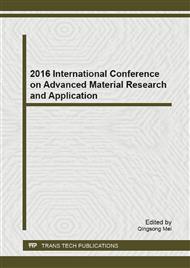[1]
L. Lee, S. -J. Park, and S. Kim, Effect of nano-sized barium titanate addition on PEO/PVDF blend-based composite polymer electrolytes, Solid State Ionics. 234 (2013) 19–24.
DOI: 10.1016/j.ssi.2012.12.011
Google Scholar
[2]
Y. Kumar, S. A. Hashmi, and G. P. Pandey, Lithium ion transport and ion–polymer interaction in PEO based polymer electrolyte plasticized with ionic liquid, Solid State Ionics. 201 (2011) 73–80.
DOI: 10.1016/j.ssi.2011.08.010
Google Scholar
[3]
D. Devaux, R. Bouchet, D. Glé, and R. Denoyel, Mechanism of ion transport in PEO/LiTFSI complexes: Effect of temperature, molecular weight and end groups, Solid State Ionics. 227 (2012) 119–127.
DOI: 10.1016/j.ssi.2012.09.020
Google Scholar
[4]
A. Reddy, P. H. Rhee, and D. Kyu, New solid polymer electrolytes ( PEO 20 – LiTDI – SN ) for lithium batteries : structural , thermal and ionic conductivity studies, J. Mater. Sci. Mater. Electron. (2015) doi 10. 1007/s10854-015-3527-9.
DOI: 10.1007/s10854-015-3527-9
Google Scholar
[5]
T. Winie and A. K. Arof, Impedance Spectroscopy: Basic Concepts and Application for Electrical Evaluation of Polymer Electrolytes:, in Impedance Spectroscopy, 1st ed., USA: Apple Academic Press, 2014, p.335–363.
DOI: 10.1201/b16706-18
Google Scholar
[6]
T. M. W. J. Bandara, M. A. K. L. Dissanayake, I. Albinsson, and B. -E. Mellander, Mobile charge carrier concentration and mobility of a polymer electrolyte containing PEO and Pr4N+I− using electrical and dielectric measurements, Solid State Ionics. 189 (2011).
DOI: 10.1016/j.ssi.2011.03.004
Google Scholar
[7]
J. Louis, A single microscopic approach for ionic transport in glassy and polymer electrolytes, Solid State Ionics. 70/71 (1994) 337–345.
DOI: 10.1016/0167-2738(94)90333-6
Google Scholar
[8]
S. Ramesh, A. H. Yahaya, and A. K. Arof, Dielectric behaviour of PVC-based polymer electrolytes, Solid State Ionics. 152-153 (2002) 291–294.
DOI: 10.1016/s0167-2738(02)00311-9
Google Scholar
[9]
Y. M. Yusof, H. A. Illias, and M. F. Z. Kadir, Incorporation of NH4Br in PVA-chitosan blend-based polymer electrolyte and its effect on the conductivity and other electrical properties, Ionics. 20 (2014) 1235–1245.
DOI: 10.1007/s11581-014-1096-1
Google Scholar
[10]
T. K. Lee, S. Afiqah, A. Ahmad, and H. M. Dahlan, Temperature dependence of the conductivity of plasticized poly (vinyl chloride)-low molecular weight liquid 50 % epoxidized natural rubber solid polymer electrolyte, J. Solid State Electrochem. (2012).
DOI: 10.1007/s10008-011-1633-z
Google Scholar
[11]
T. Winie and A. K. Arof, Dielectric Behaviour and AC Conductivity of LiCF3SO3 Doped H-Chitosan Polymer Films. Ionics 10 (2004) 193-199.
DOI: 10.1007/bf02382816
Google Scholar


